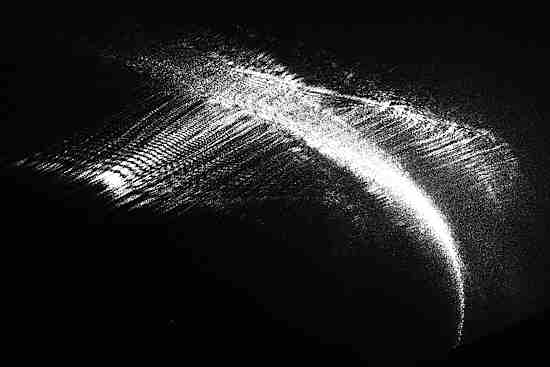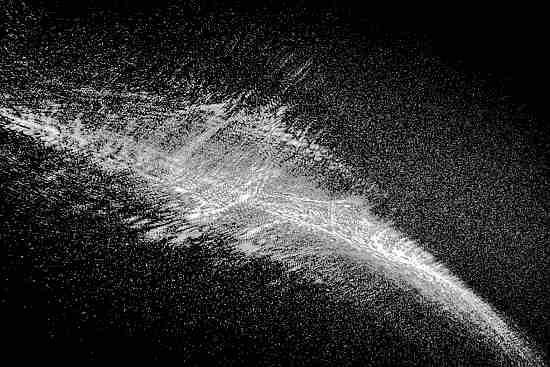Reflection
- finloc
- Oct 16, 2017
- 4 min read
Diffusely reflected laser light
Reflections are not perfect replications. All surfaces reflect, only perfect black (which does not exist) absorbs all light. No surface is perfectly flat.
Unless direct from a photon emitting light source (sun, lamp...) all light is reflected diffusely from objects, then captured by our eyes and brain. No object would be seen without reflections.
Objects appear to be coloured, because surfaces reflect some wavelengths of light, but absorb others. The colour of an object is not an intrinsic characteristic of the object. It is the colour of the light it does not absorb.
Reflecting sound waves are used to see inside objects in medicine and non-destructive testing.
Experience, upbringing and cultural perspective influence the way that we interpret objects, images and language. I can impose one meaning on an object. For another person the same object can hold a different meaning. Thought is another form of reflection.
Reflections can show surface, contents and meaning. Yet things are not as they seem. Reflections are never perfect replications.

An (interrupted) four day project with a single word brief "Reflection".
Jotted, sketched ideas, thoughts and interpretations.
Still thinking playing with pattern as repetition and reflection. Used origami to make it 3D. Researched how to fold curves in paper. Printed a reflection of a boat in water, folded wavy lines to emulate the sea and made an origami catamaran. Fun, but just layering reflection on top of reflection on top of reflection was not very inspiring.
I bought a laser pointer on the way home as a light source to experiment with light reflection.
Laser light passes through air invisibly. It reflects off a surface, bouncing into our eye and is perceived as a precise dot on the surface. I used water with a few drops of Detol or milk dissolved in it to show the laser light passing through a medium. This dispersed the light, allowed it to be seen in transit and to some extent illuminated a greater area.
What exactly is light? Apparently it is a form of electromagnetic radiation. Visible light is emitted from an light source as waves of photons, captured by the retina and interpreted by the brain.
Unless direct from a light source (Sun, lamp...), all light perceived by us is reflected off surfaces. What we see depends on the nature of the surface. Different surfaces absorb different wavelengths of light and appear to be colour of the light that is not absorbed, or rather the light that is reflected off its surface. To what extent does any object possess colour as an integral characteristic of itself? One could argue that objects do not have colour, they simply reflect certain colours of light.
I knew that light refracts as it enters water. We can also see water, so some light must also be reflected off its surface. Further experimentation showed that laser light could also be almost entirely reflected back off the underside of the transparent surface between water and air.
I also experimented with mirrored and foiled boxes but didn't get great results and abandoned them. Slower, better quality work would probably have yielded improved results.
I experimented with different lenses scavenged from childrens' toys. Later, working after dark, the naturally reflective nature of aluminium foil produced a fascinating, glowing, highly textured reflection seemingly alive with constant movement.
The texture seemed to be caused by tiny scratches on the highly polished surface of the aluminium. Of course, polishes on surfaces are caused by finer and finer grit abrasives causing the surface to be flatter and flatter, overcoming deeper, wider scratches that diffuse light reflections more. The precise nature of the laser light allowed the scratches, otherwise invisible to the human eye, to be seen. I began to see similar effects elsewhere, for instance in light reflected off an Eero Saarinen marble topped table.
The crumpling of the foil, the precision of the laser and the impossibility of holding the laser pointer absolutely still caused the reflections to constantly move, morph jerkily into different shapes and produce seemingly three dimensional shapes on the surfaces that the light was reflected onto.
Experiments to reflect the light off different shaped surfaces, convex and concave curves, showed a long, thin cylindrical surface with a wide angle of reflection spread the reflected light over the widest area. I built a light box with jig to hold the laser and a screen to capture the cast images (laser light can damage eyes).
The intensity of the laser light and constant movement made it difficult to capture the images on film, so I had to move my DSLR off the auto setting, adjust the ISO and set the aperture and shutter speed manually. Finally, after so many years, I learnt how to use it properly. Even then the images had to be manipulated a lot. The black and white images at the top of the page demonstrate the surface texture of the foil. The arresting images caused and the interaction between the light source, surface and cast reflection is what interested me the most about this short project, so I made them my output. Other images taken on my phone camera did not show the surface qualities so much, but, with a little manipulation, also produced colour images with depth and atmosphere:













Comments